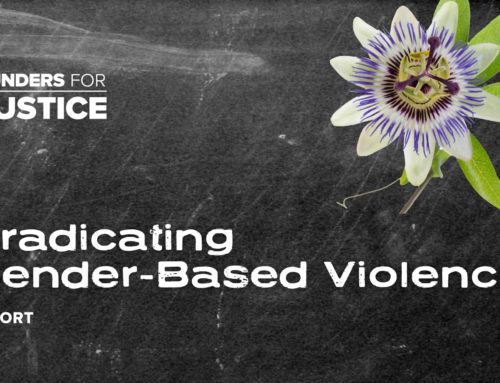Let’s Talk: At the Heart of Movement-Building – A Blog of the Movement Strategy Center
January 26, 2016
One morning last December, I found myself at the Ford Foundation watching Anna Galland, Ai-jen Poo and Heather McGhee share a stage at an event called The Future of Organizing: Contesting for Power in a Changing World. The event, co-convened by National People’s Action, was designed to highlight alignment about a shared aspiration for the progressive movement. Watching these three women, together, left me beaming.
Over the last eight years, I’ve been honored to serve as a Field or Campaign Director for MoveOn.org, the National Domestic Workers’ Alliance (NDWA), and Demos — the three organizations led by these brilliant women. The emerging alignment of these three organizations from different sectors and with very different capacities, inspired me to distill the lessons from working with them, and our allies, to lead transformative campaigns.
Transformative Campaigns are a means to create the operational alignment our progressive infrastructure needs to build a new, and specific, type of power: the power to govern based on our values. The capacities needed to govern are much different than the capacities we’ve needed to successfully elevate grievances and lead protests. In order to govern, we need political power. In order to govern with progressive and social justice values, that political power has to be independent from the two dominant political parties. That’s why a critical mass of progressive and social justice organizations is aligning around a strategic focus on building independent political power. Many of our organizations define Independent Political Power (IPP) as the scope of social change capacities that must be executed in coordination, in order to shift who governs and for what purpose.
A focus on building Independent Political Power is relatively new for many of our organizations. Infrastructure designed to make grievances is different than infrastructure designed to build the power to govern. To get somewhere different, we need to take a different path – which is why many of our organizations are experimenting with Transformative Campaigns.
Transformative Campaigns require us to do things differently. The momentum and work of these campaigns have been vehicles for organizations from the community-organizing field to expand their focus and capacities beyond protesting and mobilizing people on single issues. These organizations and their members are not content with protesting, changing laws or even transforming systems. Increasingly, they are working in complex networks and long-term partnerships to advance campaigns that change the narrative, put forward a political agenda, and elect their own members to political office.

Transformative campaigns push us to expand the lens we use to measure success. Two years ago I wrote an appeal to progressive institutions to think differently about what it means to “win.” I drew on my experience as NDWA’s Campaign Director and from work with affiliates and allies to capture some lessons from our transformative campaigns and how we measured our success. Allies’ campaigns have echoed and expanded upon these lessons:
When “winning” means having the types of power and capacities needed to govern based on our values, success is not defined solely as policy change. Success must also be measured in the increased alignment, capacities and infrastructure built in the process, together.
Governing and building independent political power cannot, and should not, be done by one organization or institution alone. Many of the progressive organizations focused on building independent political power are increasingly connected through national networks like People’s Action and the Working Families Party, as well as the multi-network capacity and field-building initiatives like the Inclusive Democracy Project and the Partnership Fund. Building and running transformative organizing campaigns is amongst the most necessary work to operationalize strategic and functional collaboration across our sectors, networks and institutions.
As a reflection on the lessons I’ve learned from these organizations and our allies, I offer Eight Features of Transformative Campaigns to describe how campaigns can be transformational (vs. transactional) — making them essential for building the alignment we need to move from grievance to governance.
1) Start with Values and Vision
Transformative Campaigns don’t start with a policy goal, a person we want to elect, or an action we want to pull off. They start with deeper purpose that is rooted in values and connected to a vision. Reaching that vision will require a long-term, multi-issue political program. Starting with values and vision must be the first step in transformative campaigning.
2) Intentionally Sequence, and Plan to Implement, Structural Reforms
Structural Reforms are reforms that:
- Address root causes of inequality;
- Restructure relations of power as a means and an end;
- Increase participation in public life and democracy (e.g., facilitating public input, negotiation, approval, and oversight into subsequent decisions and governing structures).
In order to operationalize our vision, we need a political program made up of an intentionally sequenced agenda of structural reforms. Transformative Campaigns are not isolated one-off initiatives. They are part of an intentionally sequenced set of issue priorities, mobilization, policy change and election campaigns that are pursuing structural reforms.
Too often, we’ve left the task of implementing and administering what we win up to those already in power. Structural reforms include mechanisms for us to be involved in the implementation and administration. They create ways for us to practice governance. When we plan for this we include capacity building as one key measure of success for the campaign. (For those concerned about promoting reformism at the expense of transformation: structural reforms aren’t in tension with transformation or even revolutionary change. Structural reforms differ from reformist agendas because they don’t “fix” systems that are designed to fail, exclude or oppress us. Instead, structural reforms structurally change those systems towards inclusivity. Because they are part of a long-term agenda and are executed through transformative campaigning, they do not compromise the end goal or vision for the sake of an illusory step “forward.”)
3) Engage, Constantly, in the Battle of Ideas
Invite, engage and ignite an examination of how we organize our economy, society and democracy. This means our campaigns must center, not shy away from, ideas about the role of government and the purpose of public services and regulation, markets and ownership. We must name and combat the elite’s and Right-wing’s intentional use of dog-whistle politics, patriarchy and white supremacy to advance policies that ultimately hurt all of us.
Transformative campaigns look beyond what is “winnable” in the short term and often demand the hard choice to forgo a short term “win” if it requires us to abandon the battle of ideas. We can have a “win” without a policy change if we know we’re moving the dial on how people experience, think and feel about government, race, gender, democracy, and equity. In transformative campaigns we are willing to “loose forward” — to take a short-term loss on a policy or election, rather than taking a transactional “win” that perpetuates the underlying ideas of our opposition.
For example, we don’t win voting reforms if we’ve framed them as “efficient” and “cost saving”. If we achieve a policy using neoconservative and neoliberal ideas, then we’ve failed to establish the role of government and will end up spending the next year fighting the repeal of a law we just changed. A real win requires our campaigns to unabashedly put forward the idea that government has a responsibility to facilitate participation, to create regulations that level the playing field, and to promote social good and participatory governance.
4) Commit to Scale: Embrace Culture Work, Civic Engagement, Field-Building, & the Technologies and Partnerships to Achieve Them
Transformational change, at scale, requires changing behavior, beliefs and practices. Social networking and civic engagement technologies as well as partnerships with cultural institutions and high-road businesses have proven critical to achieving changes in behavior and beliefs. Several campaigns that have had large scale impact – including Caring Across Generations and Color of Change’s ALEC campaign — have succeeded because they engaged cultural institutions and pop-culture strategies. Other organizations — including Demos and many affiliates of People’s Action — have lead innovative civic engagement initiatives and developed partnerships with high-road businesses (often B-corps) to successfully change behavior and beliefs about the role of people and government in our electoral process. The #BlackLivesMatter Network demonstrated the scale of impact of social networking technologies. Transformative Campaigns are often built with a goal of expanding a field or sector, in order to increase our ability to execute at scale.
5) Trust in Leaderful Networks Taking Direct Action
Harnessing the power of social movements to create change requires a relationship between inside and outside strategies. When we default into models of leadership that are singular (command and control) or leaderless, we limit our ability to coordinate complex strategies and distributed tactics.
- The #BlackLivesMatter network popularized an understanding of leaderful networks and beautifully demonstrates the power of encouraging leaders in various roles and styles.
- The #M4BL, #Not1More and #NoXLPipeline campaigns have demonstrated how distributed campaigning – including tactical diversity, creative and direct actions — builds leadership and scales leadership development.
Leaderful networks are necessary for supporting popular uprisings, direct actions, mobilizations and the re-birth of powerful progressive social movements that institutions don’t, and shouldn’t, be able to, control. Uprisings and social movements need to flourish in order for progressive infrastructure to have the demand, will, credibility, and accountability to govern.
6) Shift Individualism to Interdependence
Individual, organizational and structural transformation happens when seemingly independent (and often limiting) individual and group interests are put into an interdependent framework that actualizes multiple interests at once. Interdependence expands the circle of stakeholders for a desired change, generating what NDWA calls “Strategic Empathy” — the ability to make connections and see each other’s full human dignity across difference.
Moving towards interdependence is part of NDWA’s practice of “Organizing with Love”, and has informed their work to win what onlookers have called “unlikely allies” in the Caring Across Generations and the We Belong Together campaigns. Elements of this type of work are visible in what MoveOn did to organize gun-owners to take on the gun lobby and support gun control. Many of their members would say that there are no unlikely allies — just human connections we haven’t yet made. Organizing from interdependence is necessary to move people, issue areas, and institutions (or entire fields) from being siloed and isolated into connected, authentic relationships.
7) Create Solutions for All of Us Through an Inclusive, Specific and Targeted Approach
There is something uniquely powerful at the intersection of experiences where those at that intersection are in a unique position to understand how the world, and how power, work. We need leadership that comes from that place of intersection. This means our leadership and our demands must be inclusive and specific. When we find solutions that are based on equity and dignity for those of us most impacted by injustice, we create benefits and equity for all of us. The movement for Black lives has elevated the fact that valuing Black lives, in particular the lives of Black cis and trans women, improves the world for everyone. Valuing Black lives benefits Latinos, (many of whom are Black), Asians, Muslims and, yes, white people.
This principle, as applied to policy design, is exemplified in an approach called Targeted Universalism (a term coined by john powell), in which solutions are designed to be universal in terms of their goals, yet targeted with respect to the populations they specifically serve. One example is how Demos crafted a policy model for “universal” or “automatic voter registration” to be sure that policy is targeted to address racialized disparities in registration rates. This approach represents a commitment to reduce injustice and inequity by focusing resources on addressing the challenges faced by peoples and communities who have been disadvantaged by structural inequalities (racism, patriarchy, class, etc.). Targeted solutions to eliminate disparities, coupled with inclusive and specific leadership, will lead to improvements for all of us.
8) Move Into a “Forward Stance” and Expand the Realm of What Is Possible
Transformative campaigns put us on the offensive — not defensive — in moving towards our vision and the long-term (sequenced) agenda it will take us to get there. Transformative campaigns require us to be responsive to conditions, without being reactive. By being deliberately proactive, Transformative Campaigns are about the values and vision they move us toward, not just about moving away from something.
Taken together, these eight features illustrate how Transformative Campaigning achieves the dual purpose of advancing change in the near term while also building the capacities needed for Independent Political Power — power that we need to move from grievance to governance.
With our planet, lives and future at stake, we aren’t just trying to change what we are doing. We must change where we are going. We must create the infrastructure we need to govern ourselves, rather than make grievances about how we are governed. Let’s take a close look at the initiatives driving coordination and deep alignment across fields and sectors:
- What do we see when we measure our alignment as our success?
- What infrastructure expands the realm of what is possible?
- What infrastructure do we need not just to survive or be better off, but to actually govern based on our values and vision?
Our work together has pried open a path from grievance to governance. Our potential is transforming in front of us.
Let’s take our path, together.
Read the original blog post on Let’s Talk: At the Heart of Movement-Building – A Blog of the Movement Strategy Center.


